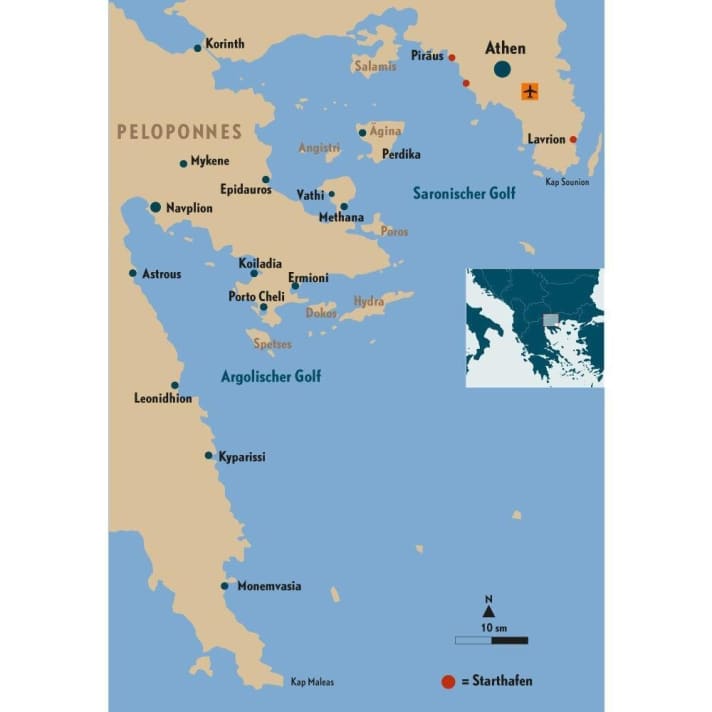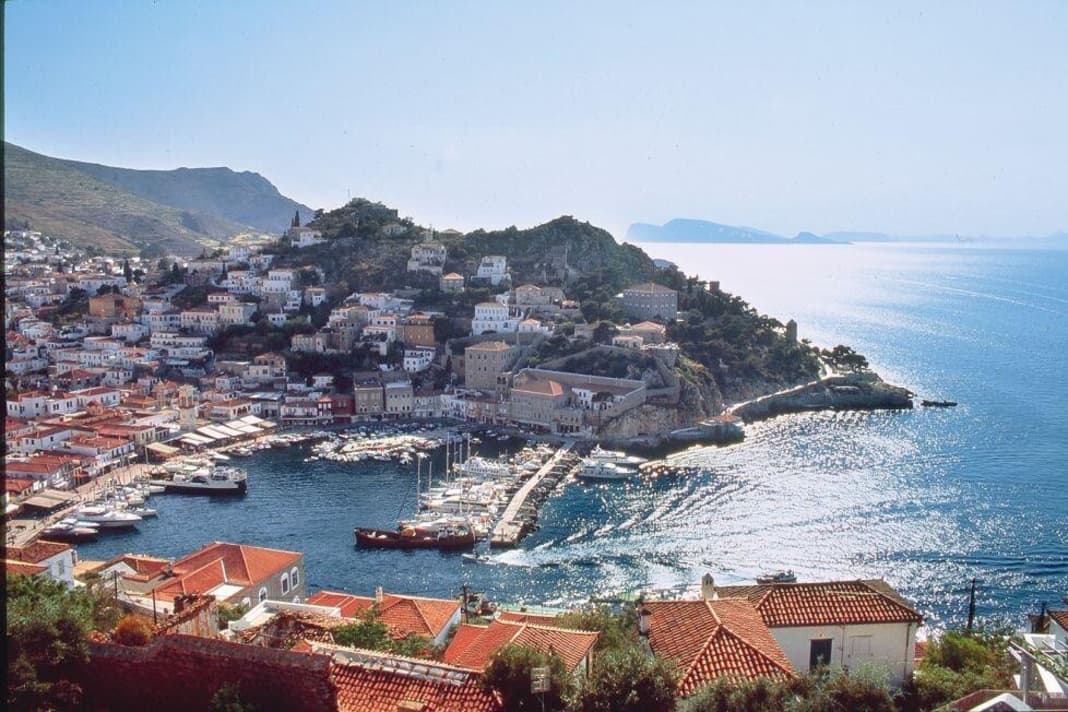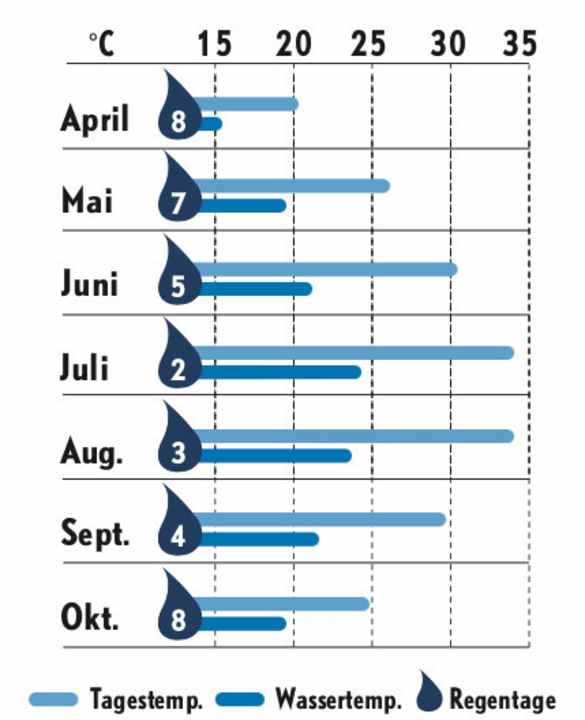

ARRIVAL
Athens is served by direct flights from many German airports; if necessary, you can change planes once in Germany. Depending on the season 200 to around 450 euros. The taxi to Kalamaki Marina takes about 40 minutes and costs around 30 to 40 euros. There is also a bus (line X96) from the terminal to a stop directly in front of the marina entrance.






CHARTER
The logical starting harbour for the area isAthensThere is a huge selection of fleets and bases in various marinas (Alimos/Kalamaki, Piraeus, Agios Kosmas). From there it isno 16 miles to the first island, Aegina. In principle, Lavrion is also an option, but from there the journey, which is then more likely to go to Poros or Hydra, is over 30 miles longer.

WIND & WEATHER
The Saronic Gulf isnot so clear from the Meltemicharacterised like the Cyclades. The area around Aegina is influenced by the Meltemi in summer, while thermal southerly winds often blow further towards Poros. Between Hydra and Trikeri, on the other hand, the wind often blows in an easterly direction. The further west crews sail, into the Argolic Gulf to Navplion, the calmer it becomes, where lulls are not uncommon in the early and late season. However, passing lows can also cause strong northerly or southerly winds at these times.
Good weather and swell forecasts can be found on the website of the Greek weather servicePoseidon (www.poseidon.hcmr.gr) and the usual sources such asWindy (www.windy.com) orWindfinder (www.windfinder.de) and its iOS and Android apps.
NAVIGATION & SEAFARING
The precinct isuncomplicatedShoals are rare, important entrances and harbours are buoyed, also because of the busy ferry traffic. The harbours are sometimes a challengefull harboursHydra in particular is chaotic when Roman Catholic yachts with bow anchors lie in several rows behind each other (!). This harbour, but also Poros, is often hit by swell from the heavy traffic of ferries and yachts from Athens.
HARBOURS & ANCHORAGES
Simple city harbours with little infrastructure, created withBow anchor and stern lines at the pier. Sanitary facilities are rare. There are no full-service marinas. There areHardly any demurrage electricity and water cost extra, if available. Everywhere you have to moor with your own Roman Catholic anchor. There areNumerous anchorages in bathing bays that are also suitable for the night. Hydra, Poros and Aegina get very crowded at weekends during the season, as the yachts swarm out from Athens.Hydra is a special case in the whole of Greece. The mooring procedure here takes the breath away from many crews: from midday onwards, the yachts arrive at a marching pace and fight for the few free places in the basin. The first row is quickly filled, then skippers start to position their boats in front of the Roman Catholic yachts, the stern lines are then attached to the bow cleats of the first row (a photo of this can be seen in the picture gallery). A borderline technique that should only be used if you are experienced and absolutely certain that the weather will remain calm at night. It is common for anchors to get salty the next morning and a trip line on the iron is recommended.
There are a number of good anchorages around the islands, the protection is not always perfect for all wind directions, but the prevailing summer winds are usually fine. In some, howeverswell at night, especially around Aegina, Poros and on Hydra's north side.
LITERATURE & NAUTICAL CHARTS
Rod Heikell, "Greek coasts", Edition Maritim. Gerd Radspieler, "Greece 1", Delius Klasing
Nautical charts: Greek pleasure craft charts GRPC 1 and 2, Chart G 16, British pleasure craft charts by Imray, "Saronic and Argolic Gulf", with plans.
TERRITORY CHARACTERISTICS
The area virtually on the doorstep of Athens is ideal for crews whodo not want to sail so far souththat the way backagainst the Meltemi and still want to experience the typical flair of a Greek island holiday destination. The Saronic Gulf with the islandsAegina,Poros,Hydra orSpetses offers an attractive sailing area just three hours sailing distance from the Greek metropolis. Car-free Hydra, whose streets are still used by donkeys to transport all loads, has a very special flair with its beautiful main town and is without question the most popular destination in the region.
From about there, the wind also changes: while Aegina and Poros are still fully under the influence of the Meltemi, the conditions around the eastern corner of the Peloponnese then often change:The wind turns partly to southerly or northerly directions and often becomes significantly weaker - often pleasant for many crews in the Meltemi phase.
There is plenty to see in the area: the island of Methoni is famous for its hot (albeit foul-smelling)Healing springs known, those who like culture can visit the sensationally well-preservedAmphitheatre of Epidauros who have a soft spot for the oldWood-Kaiki-Building Spetses, where many shipyards still build and repair traditional boats, is the place to be. In between are beautiful anchorages, for example around the island of Dokos. But the larger islands also have plenty of sheltered spots on the leeward coasts - although not always optimally protected from the swell caused by the heavy traffic around Athens.
When the Athenians swarm out with their boats at the weekend and in the high seasonsometimes it gets quite crowded in the areaThere are also many ferries on the way. But this eases off the further west you go. You can easily spend an exciting charter week between Aegina, Poros, Hydra and Spetses, but if you sail further round the corner into the Argolic Gulf and up to its largest town, Navplion, for example, you will encounter fewer and fewer yachts. The old, pretty town with its fortress at the top of the mountain is well worth a visit, and there are some nice little villages hidden in the gulf where you can anchor.
Does the wind give itwhich is not always the case in the early and late season, you can enjoy a30-mile detour down the Peloponnesethere liesMonemvasias historic old town on the hill. The ensemble of colourful, lovingly restored houses and winding alleyways below and the dilapidated upper town is a fantastically beautiful destination. However, if you want to sail this far, you need to plan a 14-day trip.
In terms of infrastructure, the Saronic Gulf is a typical Greek sailing area: hardly any service or sanitary facilities, often bow anchors, but ridiculously low mooring fees, sometimes less than 10 euros for a 42-foot boat.

